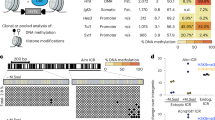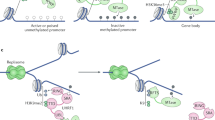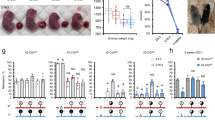Abstract
Data derived from both pronuclear transplantation experiments and classical genetic experiments indicate that the maternal and paternal genetic contributions to the mammalian zygote nucleus do not function equivalently during subsequent development1–5. These observations have been interpreted as resulting from differential 'genome imprinting' during male and female gametogenesis2,3. The molecular mechanism responsible for genome imprinting is unknown, but data gathered to date require that the mechanism fulfil at least four criteria: (1) the imprint must be physically linked to the pronucleus2,3; (2) the imprint must persist through DNA replication and cell division6; (3) the mechanism must be capable of affecting gene expression2,7; and (4) the mechanism must be capable of switching the identity of the imprint from one sex to the other in successive generations2,3. One molecular mechanism which could satisfy the first three criteria is differential DNA methylation during gametogenesis itself6,8, or before formation of the zygote nucleus during embry-ogenesis. We present data indicating that the methylation patterns of exogenous DNA sequences in transgenic mice can be changed by switching their gamete of origin in successive generations. These data suggest that DNA methylation can also satisfy the fourth criterion for an imprinting mechanism.
This is a preview of subscription content, access via your institution
Access options
Subscribe to this journal
Receive 51 print issues and online access
$199.00 per year
only $3.90 per issue
Buy this article
- Purchase on Springer Link
- Instant access to full article PDF
Prices may be subject to local taxes which are calculated during checkout
Similar content being viewed by others
References
1. McGrath, J. & Solter, D. Science 220, 1034–1036 (1983). 2. Surani, M. A. H., Barton, S. C. & Norris, M. L. Nature 308, 548–550 (1984). 3. McGrath, J. & Solter, D. Cell 37, 179–183 (1984). 4. Cattanach, B. M. & Kirk, M. Nature 315, 496–498 (1985). 5. Surani, M. A. H. Barton, S. C. & Norris, M. L. Nature 326, 395–397 (1987). 6. Surani, M. A. H., Barton, S. C. & Norris, M. L. Cell 45, 127–136 (1986). 7. McGrath, J. & Solter, D. Nature 308, 550–551 (1984). 8. Surani, M. A. H. in Experimental Approaches to Mammalian Embryonic Development (eds Rossant, J. & Pedersen, R. A.) 401–435 (Cambridge University Press, 1986). 9. Sanford, J., Forrester, L., Chapman, V. M., Chandley, A. & Hastie, N. Nucleic Acids. Res. 12, 2823–2836 (1984). 10. Sanford, J. P., Chapman, V. M. & Rossant, J. Trends Genet. 1, 89–93 (1985). 11. Monk, M., Boubelik, M. & Lehnert, S. Development 99, 371–382 (1987). 12. Baldwin, A. S., Kittler, E. & Emerson, C. P., Jr Proc. natn. Acad. Sci. U.S.A. 82, 8080–8084 (1985). 13. Jaehner, D. et al Nature 298, 623–628 (1982). 14. Klar, A. J. S. Nature 326, 466–470 (1987). 15. Bird, A. P. Nature 321, 209–213 (1986). 16. Myers, R. H. et al. Lancet i, 208–210 (1983). 17. Farrer, L. A. & Connealy, P. M. Am. J. hum. Genet. 37, 350–357 (1985). 18. Froster–Iskenius, U., McGillivray, B. C., Dill, F. J., Hall, J. G. & Herbst, D. S. Am. J. Med. Genet. 23, 619–631 (1986). 19. Hogan, B., Costantini, F. & Lacy, E. Manipulating the Mouse Embryo, A Laboratory Manual (Cold Spring Harbor Laboratory, 1986). 20. Maniatis, T., Fritsch, E. F. & Sambrook, J. Molecular Cloning, A Laboratory Manual (Cold Spring Harbor Laboratory, 1982). 21. Wyman, A. R. & White, R. Proc. natn. Acad. Sci. U.S.A. 77, 6754–6758 (1980).
Author information
Authors and Affiliations
Rights and permissions
About this article
Cite this article
Sapienza, C., Peterson, A., Rossant, J. et al. Degree of methylation of transgenes is dependent on gamete of origin. Nature 328, 251–254 (1987). https://doi.org/10.1038/328251a0
Issue Date:
DOI: https://doi.org/10.1038/328251a0
This article is cited by
-
Role of genomic imprinting in mammalian development
Journal of Biosciences (2020)
-
Functions and mechanisms of epigenetic inheritance in animals
Nature Reviews Molecular Cell Biology (2018)
-
Loss of the zona pellucida-binding protein 2 (Zpbp2) gene in mice impacts airway hypersensitivity and lung lipid metabolism in a sex-dependent fashion
Mammalian Genome (2018)
-
Genomic imprinting: theories and data
Heredity (2014)
-
Epigenetic Inheritance of Disease and Disease Risk
Neuropsychopharmacology (2013)
Comments
By submitting a comment you agree to abide by our Terms and Community Guidelines. If you find something abusive or that does not comply with our terms or guidelines please flag it as inappropriate.



